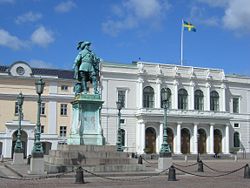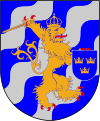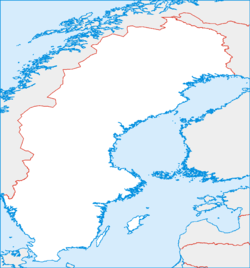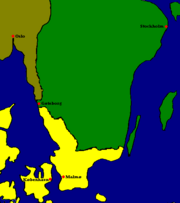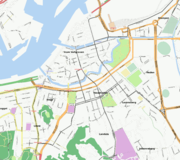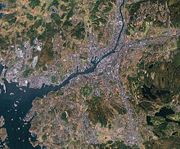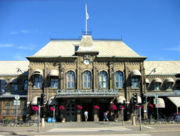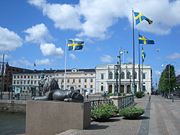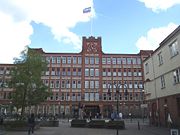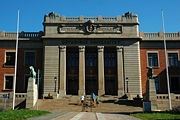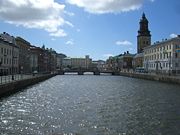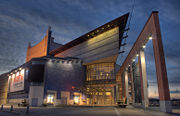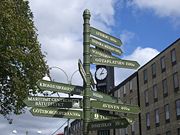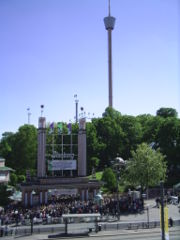Gothenburg
2008/9 Schools Wikipedia Selection. Related subjects: Europe; European Cities
| Gothenburg Göteborg |
|||
|
|||
| Nickname: "Lilla London" (Little London) |
|||
| Coordinates: | |||
|---|---|---|---|
| Country | Sweden | ||
| Municipality | Gothenburg Municipality, Härryda Municipality, Partille Municipality and Mölndal Municipality |
||
| County | Västra Götaland County | ||
| Province | Västergötland and Bohuslän | ||
| Charter | 1621 | ||
| Government | |||
| - Mayor | Göran Johansson | ||
| Area | |||
| - City | 450 km² (173.7 sq mi) | ||
| - Water | 14.5 km² (5.6 sq mi) 3.2% | ||
| - Urban | 198.16 km² (76.5 sq mi) | ||
| - Metro | 3,717 km² (1,435.1 sq mi) | ||
| Population (2008) | |||
| - City | 494,806 | ||
| - Density | 1,083/km² (2,805/sq mi) | ||
| - Urban | 510,491 | ||
| - Urban Density | 2,576/km² (6,671.8/sq mi) | ||
| - Metro | 896,157 | ||
| - Metro Density | 238/km² (616.4/sq mi) | ||
| Time zone | CET ( UTC+1) | ||
| - Summer ( DST) | CEST ( UTC+2) | ||
| Website: www.goteborg.se | |||
Gothenburg ( Swedish: Göteborg ) /jœte'bɔrj/) is a city, a municipality, and an urban area on the west-coast of Sweden.
As of 2006, the population was 489,787 in the municipality and 510,491 in the urban area, making it the second largest city in Sweden, after Stockholm and the fifth largest amongst the Nordic countries. The metropolitan area, which is a statistical area, encompassing thirteen municipalities in western Sweden has 890,000 inhabitants.
The City of Gothenburg was founded in 1621 by the King Gustavus Adolphus of Sweden. It is situated at the mouth of Göta Älv river, which crosses the city, and is the largest sea port of Sweden as well as of the Nordic countries. Gothenburg is also a significant university city with a large student population of both the University of Gothenburg, which is Scandinavia's largest university, and Chalmers University of Technology.
Name
The city was named after the Geats (Swedish: Götar varied: Geatas, Gautar, Goths, Gotar, Gøtar, Götar), the inhabitants of southern Sweden - i.e. "Defense of the Geats". The river on which the city sits is the Götaälv or Göta River. Göta borg is the fort on the Göta River, built to protect the port, which was created to be Sweden's commercial window to the west.
In Dutch, Scots, German and English - languages with a long history of being spoken in the trade and maritime-oriented city - the name Gothenburg has traditionally been used for the city, while the French form of the city name is Gothembourg. Gottenburg is seen in some older English texts. These traditional forms are now sometimes replaced with the use of the Swedish Göteborg, for example by the Göteborg Opera, Göteborg Ballet, Göteborg Film Festival, and by the city itself (in English, the City of Göteborg). Many British newspapers, and the U.S. Navy, also refer to the city in English as Göteborg. Effective February 1, 2008, however, Göteborgs Universitet, previously named Göteborg University in English, changed to the University of Gothenburg. Other old variations in Swedish are Götheborgh, and the most common, Götheborg.
History
In the 16th and 17th century, the configuration of Sweden's borders made Gothenburg strategically important as the Swedish gateway to the west, lying on the west coast in the narrow area between the territories of Denmark-Norway. After several failed attempts, Gothenburg was successfully founded in 1621 by King Gustavus Adolphus (Gustaf II Adolf). The city was heavily influenced by the Dutch. Dutch city planners were contracted to build the city as they had the skills needed to build in the marshy areas around the city. The town was planned after Dutch cities to have canals like Amsterdam, and the blueprint for the canals of Gothenburg are actually the same as those used for Jakarta. The Dutchmen initially won political power and it was not until 1652, when the last Dutch politician in the city's council died, that the Swedes acquired political power over Gothenburg. During the Dutch period the town followed Dutch town laws and there were propositions to make Dutch the official language in the town.
Along with the Dutch, the town also was influenced by the Scottish, that came to settle down in Gothenburg. Many became people of high profile and one such person was William Chalmers, who donated his fortunes to create what later became Chalmers University of Technology. The Scottish influence can still be felt in Gothenburg in present day as names like Glenn and Morgan, which in the rest of Sweden usually are rare, are not uncommon in Gothenburg, and the use of a Scottish sounding "r" in the local dialect.
The Gothenburg coat of arms was based on the lion of the coat of arms of Sweden, symbolically holding a shield with the national emblem, the Three Crowns, to defend against its enemies.
In the Treaty of Roskilde (1658) Denmark-Norway ceded the then Danish province Halland, to the south, and the Norwegian province of Bohus County or Bohuslän to the north, leaving Gothenburg in a less exposed position. Gothenburg was able to grow into an important port and trade centre on the west coast thanks to the fact that it was the only city on the west coast that was granted, together with Marstrand, the rights to trade with merchants from other countries.
In the 18th century, fishing was the most important industry. However, in 1731 the Swedish East India Company was founded, and the city flourished due to its foreign trade with highly profitable commercial expeditions to Asian countries.
The harbour developed into Sweden's main harbour for trade towards the west, and with the Swedish emigration to North America increasing, Gothenburg became Sweden's main point of departure. The impact of Gothenburg as a main port of embarkation for Swedish emigrants is reflected by Gothenburg, Nebraska, a small Swedish settlement in the United States.
With the 19th century, Gothenburg evolved into a modern industrial city that continued on into the 20th century. The population increased tenfold in the century, from 13,000 (1800) to 130,000 (1900). In the 20th century major companies that developed included SKF (est. 1907) and Volvo (est. 1926).
In more recent years however, the industrial section has faced a recession, which has spurred the development of new sectors such as increased merchandising, tourism and cultural and educational institutions.
In 2001, major protests occurred in the city during the EU summit and the visit by U.S. president George W. Bush.
Politics and government
See Gothenburg Municipality
Climate
Gothenburg has humid continental climate with pleasant, mild summers and cold winters. The city has milder winter but cooler summers than most cities in same latitude.
Typical temperatures and precipitation for each month:
| Weather averages for Göteborg | |||||||||||||
|---|---|---|---|---|---|---|---|---|---|---|---|---|---|
| Month | Jan | Feb | Mar | Apr | May | Jun | Jul | Aug | Sep | Oct | Nov | Dec | Year |
| Average high °C (°F) | 1 (34) | 2 (35) | 5 (41) | 9 (49) | 16 (61) | 19 (67) | 20 (68) | 20 (68) | 20 (68) | 16 (61) | 11 (52) | 6 (43) | |
| Average low °C (°F) | -3 (26) | -4 (25) | -1 (30) | 2 (36) | 7 (45) | 11 (52) | 13 (55) | 12 (54) | 9 (49) | 6 (43) | 2 (35) | -2 (29) | |
| Precipitation mm (inches) | 69 (2.7) | 41 (1.6) | 53 (2.1) | 43 (1.7) | 48 (1.9) | 58 (2.3) | 71 (2.8) | 74 (2.9) | 84 (3.3) | 86 (3.4) | 86 (3.4) | 76 (3) | 789 (31.1) |
| Source: World Weather Information Service 2008-01-06 | |||||||||||||
Geography
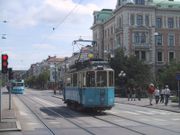
Spårvagen – Gothenburg's popular tram system covers most of the city (the one shown here is a vintage tram popular with visitors).
|
Gothenburg is located on the west coast, in Southwestern Sweden, approximately half way between the capitals Copenhagen, Denmark, and Oslo, Norway. The location at the mouth of the river Göta älv, which feeds into Kattegatt, an arm of the North Sea, has helped the city grow in significance as a trading city. Due to the Gulf Stream the city has a mild climate and quite a lot of rain.
The archipelago of Gothenburg consists of rough, barren rocks and cliffs, which also is typical for the coast of Bohuslän.
The Gothenburg Metropolitan Area extends to the municipalities of Ale, Härryda, Kungälv, Lerum, Mölndal, Partille, Stenungsund, Tjörn, Öckerö in Västra Götaland County, and Kungsbacka in Halland County.
Transport
Air
Gothenburg-Landvetter Airport is an international airport serving the Gothenburg region in Sweden. With 5.2 million passengers in 2005 it is Sweden's second-largest airport. It is operated by the Swedish Civil Aviation Administration (Luftfartsverket). The airport is named after the small town of Landvetter, which is located in the municipality of Härryda. It is 20 km east of Gothenburg. It traditionally has had two terminals, domestic and international, but they are now considered one single terminal. There is only one check-in area now, since all luggage has to be screened.
Gothenburg's second international airport is Gothenburg City Airport formerly known as Säve Flygplats and Sweden's 7th largest airport. It is located within the borders of Gothenburg Municipality. Prior to the arrival of Ryanair in 2001, the airport had 9000 passengers per year. In 2005, more than 500,000 flew from City Airport. In addition to commercial airlines, the airport is also operated by a number of rescue services, including the Swedish Coast Guard. Due to its location many business jets prefer flying to City Airport rather than Landvetter. Gothenburg City Airport can handle planes up to the size of a Boeing 767, an Airbus A320 or similar jets. The airport also accommodates General Aviation acitivities, including 2 flying clubs, Aeroklubben i Göteborg, one of Europe's oldest flying clubs, and Chalmers flygklubb.
Sea
The Swedish company Stena Line operates between Gothenburg/ Fredrikshavn in Denmark and Gothenburg/ Kiel in Germany
The "England ferry" (Englandsfärjan) to Newcastle (currently run by the Danish company DFDS Seaways) ceased at the end of October 2006, after being a Gothenburg institution since the 19th century. The company cited high fuel prices and new competition from low-cost air services, especially Ryanair, as being the cause. DFDS Seaways' sister company, DFDS Tor Line, will continue to run scheduled freight ships between Gothenburg and several English ports, and these have limited capacity for passengers, but not private vehicles. It is unclear if the Gothenburg-Kristiansand route will continue.
Rail and intercity bus
Other major transportation hubs are Centralstationen ( Gothenburg Central Station) and the Nils Ericson Terminal with trains and buses to various destinations in Sweden, as well as connections to Oslo and Copenhagen (via Malmö).
Freight
Gothenburg is a logistic centre, with transports by train and truck from Sweden and Norway to Gothenburg harbour which is by far the largest port in Scandinavia with a cargo turnover of 36.9 million tonnes a year (2004).
Public transport
With about 80 km of double track the Gothenburg tram is the largest tram/light rail network in Northern Europe. The bus network, however, is almost as important. There are also some boat and ferry services. The lack of a subway is due to the soft ground on which Göteborg is situated. Tunnelling is very expensive in such conditions. There is also a commuter rail in Gothenburg.
Demographics
Gothenburg, as with most Swedish metropolitan areas, has a large immigrant population. According to Statistics Sweden in 2005, there are 98,480 immigrants resident in Gothenburg, which is about 20% of the population, out of which 10% are from Iran and 9% from Finland. The Iranian population, as well as other immigrants from the Middle East (notably Iraq) and former Yugoslavia, is concentrated in Angered (most notably Hjällbo and Hammarkullen) and other suburbs in the north east ( Bergsjön), while other immigrants from Scandinavia, Southern Europe (notably Portugal, Italy and Greece) and Eastern Europe are far less segregated. Frölunda is also known for its larger Chinese population. Other notable East and South East Asian nationalities are the Thais and the Vietnamese.
Economy
By its naturally advantageous location, Gothenburg houses the largest harbour installation in Scandinavia. Trade and shipping have always been important businesses and in the 18th century, the city was the home to the Swedish East India Company. Industry developed into an important business, e.g., SKF, Volvo, and Ericsson.
The blue collar industries dominated until the early 1970s when shipyards started to shut down. The traditional industries are still important for the economy, with Volvo Cars being the largest employer not including a significant number of automotive parts suppliers, but high tech industries have grown up alongside them, with a number of smaller computer software vendors. Banking and finance are also important trades as well as the event and tourist industry.
Education
Gothenburg has two universities, both of which started off as colleges founded by private donations in the 19th century. The (public) University of Gothenburg has approximately 50,000 students and is the largest university in Scandinavia and one of the most versatile in Sweden. Chalmers University of Technology is a notable private university located in Johanneberg 2 km south of inner city.
There are also four folk high schools (Arbetarrörelsens Folkhögskola i Göteborg, Folkhögskolan i Angered, Göteborgs Folkhögskola, and Kvinnofolkhögskolan).
Gothenburg has some 25-30 high schools. Three of the more notable schools are Hvitfeldtska gymnasiet, Sigrid Rudebecks Gymnasium and Göteborgs Högre Samskola.
Culture
The sea, trade and industrial history of the city is evident in the cultural life of Gothenburg. The biggest attraction in the city is the amusement park Liseberg (see Sites of interest). Another fact related to the industrial heritage of the city is that many of the cultural institutions, as well as hospitals and the university, were created thanks to donations from rich merchants and industrialists, for example the Röhss Museum.
The 1923 Gothenburg Industrial Exhibition saw the creation of the art museum and a number of other institutions. The event culture of the city was an important factor behind the creation of a number of other sport and cultural institutions.
There are many free theatre ensembles in the city, besides institutions like Gothenburg City Theatre, Backa Theatre (youth theatre), and Folkteatern.
The Gothenburg Film Festival, held each year, is the biggest film festival in Scandinavia. Similarly, the Gothenburg Book Fair, held every year in September, is the largest such event in Scandinavia.
Architecture
There are very few houses left from the 17th century when the city was founded, since all but the military and royal houses were built of wood. One example is Skansen Crown.
The first major architecturally interesting period is the 18th century when the East India Company made Gothenburg an important trade city. Imposing stone houses with a Classical look were erected around the canals. One example from this period is the East India House, which today houses Gothenburg’s City Museum.
In the 19th century the wealthy bourgeoisie begun to move outside the city walls which had protected the city when the Union of Denmark and Norway was still a threat. The style now was an eclectic, academic, somewhat over decorated style which the middle-class favoured. The working class lived in the overcrowded city district Haga, in wooden houses.
In the 19th century the first important town plan after the founding of city was created, which led to the construction of the main street Kungsportsavenyn. The perhaps most significant type of houses of the city, Landshövdingehusen, were built in the end of the 19th century; three story-houses with the first floor in stone and the other two in wood.
A very important period in the architectural history of the city was the early 20th century, when the National Romantic style dominated. Among the many monumental building erected the Masthugget Church can be mentioned.
And in the beginning of the 1920s, when the city celebrated its 300th anniversary, the Götaplatsen square with its Neo-Classical look was built.
After this the predominant style in Gothenburg and rest of Sweden was Functionalism which especially dominated the suburbs like Västra Frölunda and Bergsjön. In the 1950s the big stadium Ullevi was erected when Sweden hosted the 1958 World Cup in football.
The modern architecture of the city is being formed by such architects as Gert Wingårdh who started as a Post-Modernist in the 1980s.
A further remarkable construction is Brudaremossen TV Tower, one of the few partially guyed towers in the world.
Music
Gothenburg has a rich music life - the Gothenburg Symphony Orchestra is the best known when it comes to classical music. Gothenburg also was the birthplace of the Swedish composer Kurt Atterberg. Bands like The Soundtrack of Our Lives and Ace of Base are well known pop representatives of the city. There is also an active indie scene. For example, the musician Jens Lekman was born in the suburb of Angered and named his 2007 release Night Falls Over Kortedala after another suburb ( Kortedala).
The city is also noted for being the centre of the melodic death metal movement (sometimes even called " The Gothenburg sound"). Gothenburg metal is unique and distinct because of its mixture of brutality and aggression with very melodic and sometimes progressive guitar riffs and solos. Often, keyboards and clean singing are incorporated (instead of just using the traditional death grunt vocals). Gothenburg's own At the Gates, In Flames and Dark Tranquillity are credited with pioneering this melodic style. Another well known band in the Gothenburg scene is Soilwork, although they reign from Helsingborg. The Gothenburg metal has influenced numerous significant death metal and metalcore scenes across Europe and the rest of the world, including Finland, the United States, and Canada.
Food and drink
Gothenburg, with its location by the sea, is famous for its many fish dishes and varieties of these dishes. Various fish restaurants exist in the city, all from low class shacks to world class eateries. The city also has a number of star chefs – over the past decade, 7 of the Swedish Chef of the Year Awards have been won by Gothenburgers. A popular place to buy fish ingredients is the Feskekôrka ("Fish Church"); an indoor fish market, which got its name from the building's resemblance to a Gothic church. Five Gothenburg restaurants have a star in the 2008 Michelin Guide: 28 +, Basement, Fond, Kok&Vin and Sjömagasinet.
Sports
|
|
Sites of interest
Gothenburg has a number of cultural establishments. A new opera house was inaugurated in 1994, the Gothenburg Opera. Museums include art ( Gothenburg Museum of Art) and ( Göteborgs Konsthall), design and handcrafts (the Röhss Museum), sea history, natural history, science, East India, and the Museum of World Culture inaugurated in 2004.
Kungsportsavenyn, commonly known as just Avenyn, "The Avenue", is the main boulevard. It was created in the 1860s and 1870s as a result of an international town planning competition. With a total length of about one kilometer, it stretches from the old moat at the edge of the older part of Gothenburg, and ends at the Götaplatsen square, where the Gothenburg Museum of Art and several other cultural institutions are located.
Avenyn passes the Stora teatern, a Neo-Renaissance theatre and opera building from 1859, and has the citys biggest concentration of pubs, discoteques and restaurants.
The Göteborg Botanical Garden is considered to be one of the most important botanical gardens in Europe with three stars in the French Guide Rouge.
Next to the botanical garden is Gothenburg's largest park, Slottsskogen, where the Natural History Museum (Naturhistoriska Museet) is located. The park is also home to the city's oldest observatory.
The amusement park Liseberg located in the central part of the city, is the largest in Scandinavia by number of rides, and the most popular attraction in Sweden by number of visitors per year (>3 millions). Located near Liseberg is a science discovery centre named Universeum.
One of Gothenburg's most popular tourist attractions is the archipelago ( Southern Gothenburg Archipelago), which can be reached by boat. Älvsborg Fortress, Vinga and Styrsö islands are popular places to visit.
Twin towns
 Aarhus, Denmark
Aarhus, Denmark Bergen, Norway
Bergen, Norway Chicago, USA
Chicago, USA Kraków, Poland
Kraków, Poland Lyon, France
Lyon, France Oslo, Norway
Oslo, Norway Rostock, Germany
Rostock, Germany Shanghai, People's Republic of China
Shanghai, People's Republic of China St. Petersburg, Russia
St. Petersburg, Russia Tallinn, Estonia
Tallinn, Estonia Turku, Finland
Turku, Finland Port Elizabeth, Republic of South Africa
Port Elizabeth, Republic of South Africa
